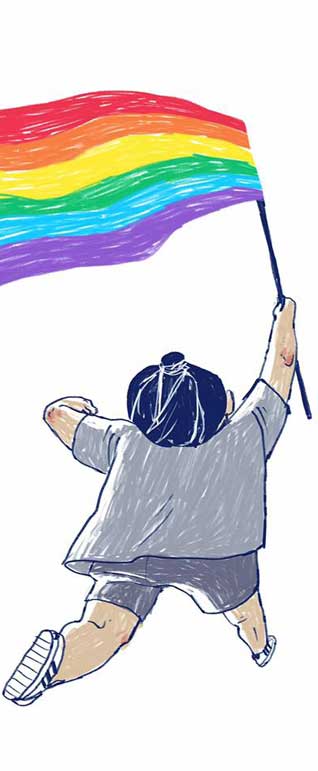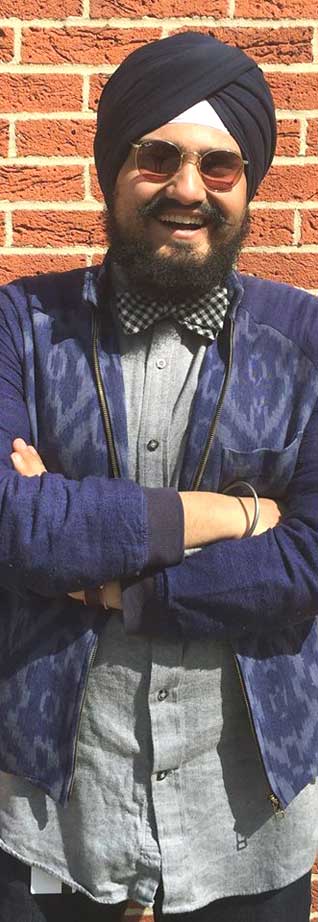Art
To Babes, With Love:
An Illustrator Explores The Intersection Between Queer And Sikh Pride
HARSIMRAN SINGH GILL
Last year, as Instagram was inundated with messages and images of mourning after the shooting at a gay nightclub in Orlando, Florida, one post in particular stuck out.
It was a sketch of a Sikh boy wearing a patka running down the street, carrying a giant rainbow flag trailing in the wind behind him.
The queer Sikh boy, a self-portrait of illustrator Jasjyot Singh Hans, was a rare representation of identities that are hardly ever seen side by side.
“I know very few gay Sikhs who are publicly out, and while there might be a considerable amount of writing on the subject, not many people are talking about it visually,” he said.
Jasjyot’s work is instantly recognisable to his followers, particularly because of the distinctive women he has been sketching for years. Full-bodied, with dense jet-black mane, these women appear everywhere he goes – in notebooks, restaurant table mats, paper plates, bags, even on delicate little doilies. Drawn in strong black lines, with raw tints of pink blush, they are often languorous, pensive, angry or sensual, but never objectified or eroticised. Whether wrapped in an abundance of frills or stark naked, they exude a complete lack of interest in the viewer – they exist entirely on their own terms.
“I’ve always found the female form easy to draw,” said Jasjyot. “I don’t know when exactly I began drawing bigger women but a lot of it came from my own body. I didn’t need references because I’ve always been bigger. It just came naturally.”
More recently, sketches of nude men have begun to appear on his Instagram feed, but unlike the women, they are fetishised: muscular, hairy, well-endowed objects of desire.
“They’ll never really be able to take the place that the women hold in my heart,” Jasjyot said. “I started including the men because I wanted to include more visibly queer work but the women are just much closer to my soul.”
Two years ago, the young man from Delhi moved to Baltimore for an MFA degree in Illustration Practice at Maryland Institute College of Art. At art school, Jasjyot began to explore queerness in his work.
“I think the distance helped me gain some perspective, but I was also wary of making work like this in India,” he said.
From sketching “bears” (as big, hairy men are dubbed in gay culture) Jasjyot has begun to look inwards, at his own life, to memories of growing up in Delhi. For his recently concluded final year thesis, he decided to forego his portraiture to create comic zines which dive deep into the life of a young, queer Sikh boy.
In ‘Baby Let’s Cruise‘, for instance, Jasjyot takes readers on a hilarious journey through the shallow world of gay cruising apps. From the muscle men who describe themselves as “not into feminine or fat guys” to the endless profile pictures of headless torsos, it is a turbulent ride that is all too familiar to anyone who has spent time on Grindr.
“There really isn’t much difference, whether it’s Delhi or Baltimore – it’s all about having that perfect body,” he said.
Jasjyot’s most autobiographical comic, ‘To Babes, With Love’ is the most vulnerable. Soaked in nostalgic tones of peach and yellow, it looks back at his life growing up in a Sikh family in Karkardooma, a neighbourhood in East Delhi.
“It was initially supposed to be a much shorter comic which explored coming out to my parents but it became something else,” he said.
All too often, coming-out stories are seen as both the start and end of queer narratives, a grand declaration, accompanied by a few happy or sad tears of resolution. Life continues as before, once announcement has been made.
‘To Babes, With Love’ remains, thankfully, messy. Jasjyot goes deep to unpack the tricky world of masculinity, particularly for a Sikh man.
Peppered with his distinctive sense of humour, the comic is an immediately recognisable peek into growing up gay in a world that assumes heterosexuality and masculine performativity. In one of the panels, a shy young Jasjyot finds himself in a locker room full of cricketers, many of them wearing nothing but a jockstrap – a completely unknown but exciting world.
School was not always so easy for the young Jasjyot. From homophobic slurs to always being picked last for the cricket team, the comic showcases the range of casual cruelty meted out to children who do not conform. In a particularly heart-breaking panel, Jasjyot portrays his younger self locked and weeping in a bathroom cubicle, while bullies try to kick down the door and call him names.
“What else can you expect from an all-boys school?” he said with a sigh.
There was little drama or violence of this sort when Jasjyot came out to his family.
“I know I’m lucky but particularly with people of colour, queer stories are expected to be only traumatic,” he said. “But there are many stories out there, what we really need is for all kinds of stories to be told.”
As a result, the comic’s depicts home as an oasis of warmth and calm, anchored by the comforting rituals of TV soaps, a bedtime glass of milk, a loving mother and the eponymous “Babes” – the nickname with which Jasjyot’s father’s number is saved on his mother’s phone.
A senior national selector for the Indian cricket team and a Ranji Trophy record-holder, Babes ticks all the boxes for the ideal Sikh man. Running through Jasjyot’s narrative is the constant needling from everyone around him to live up to this masculine legacy.
“I’ve always been scared to let him down,” he writes in the comic. “And not in a ‘model-Indian-child-who-will-prove-his-worth-for-his-parents’ kind of way. I considered myself far from model.”
Yet Babes is the antithesis of the formidable patriarch. He is married to a woman who refuses to cater to his whims. The cricket World Cup never wins over the soaps that the rest of the family wants to watch. Babes shows vulnerability when he fails, supplies young Jasjyot with a steady stream of sketch pens instead of cricket bats. He is not a trope, but an entirely original Sikh man and crucially, a proud father.
“There are things I will never be able to speak to him directly about,” writes Jasjyot at the end of his comic. “But we’re getting there and that’s perfectly okay.”
This is what makes Jasjyot Singh’s work luminous: he shows his readers an alternative to the script of toxic and hyper masculinity, one that allows for the depiction of women who are not sexualised objects and one that encourages little Sardars to run proudly down the street, a giant rainbow flags fluttering behind them.
[Courtesy: Scroll. Edited for sikhchic.com]
May 4, 2017




